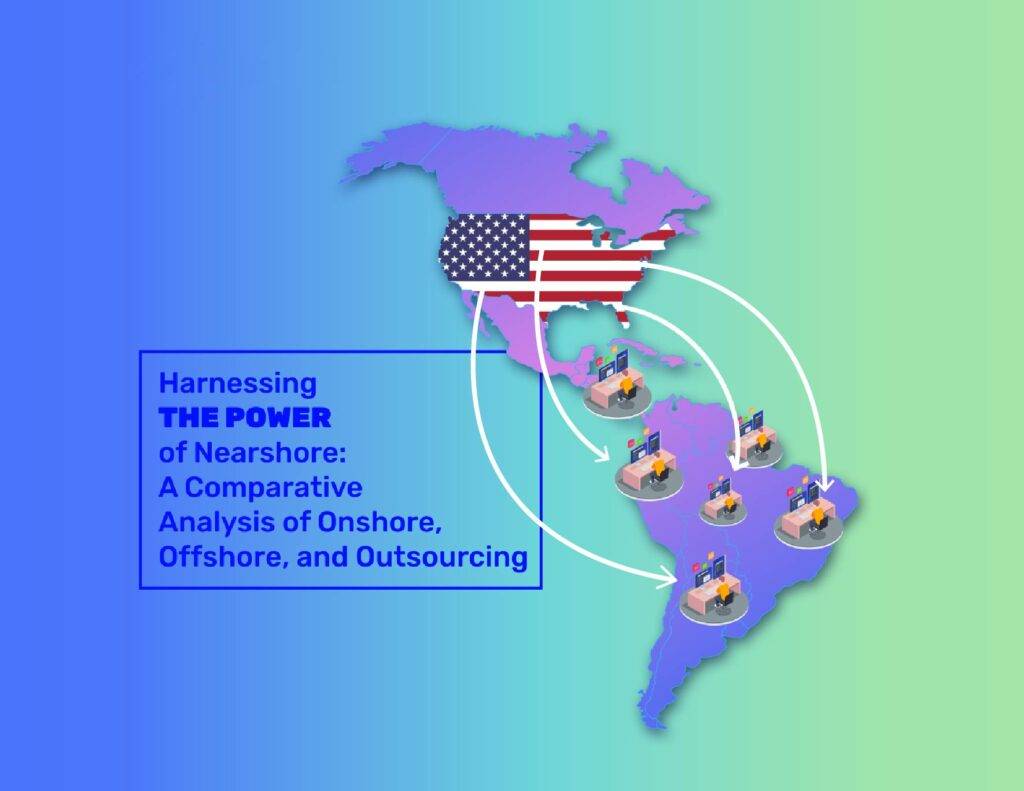In an era characterized by globalization and rapid technological advancements, businesses strive to balance operational efficiency and cost-effectiveness. Central to this endeavor is the strategic choice of where and how to source their software services and human resources. Four common models emerge in this context: onshore, offshore, outsourcing, and nearshore. Each model brings unique advantages and challenges to the table, and businesses need to understand these to make an informed decision.
This article seeks to provide an in-depth comparison of these four models, highlighting their respective strengths and weaknesses. However, it pivots on the premise that nearshore, as a model of sourcing software services and talent, outshines the other options for US-based businesses.
Onshore refers to obtaining services within the same country where the company is based; offshore means sourcing services from a geographically distant country. Outsourcing is the practice of having certain job functions done outside a company instead of having an in-house department or employee handle them. On the other hand, nearshore refers to outsourcing business processes or services to companies in nearby or neighboring countries.
As we proceed to unravel the dynamics of these models, the focus will gravitate towards advocating nearshore, especially for US-based companies. The discussion will highlight the unique benefits of the nearshore model, from cost-effectiveness, proximity, and cultural compatibility, to the richness of the talent pool, specifically focusing on Latin America’s growing Software Development industry.
Join us as we explore these fascinating landscapes of global business operations and reveal why nearshore could be your optimal strategy.
Overview of the Four Options
Onshore
Onshoring, also known as domestic outsourcing, involves sourcing services from within the same country where a company is located. This model fosters strong communication due to shared language and cultural understanding and facilitates seamless coordination because of the same time zone. However, onshoring can be expensive due to higher labor costs, strict regulations, and workforce scarcity.
Offshore
Offshoring involves outsourcing tasks or services to a country far from a company’s location. This model often provides a cost advantage due to the lower wages in offshore countries. Businesses can tap into a large, diverse talent pool and get services around the clock due to different time zones. However, offshoring can pose challenges in communication and coordination due to language barriers, cultural differences, and time zone differences.
Outsourcing
Outsourcing involves delegating certain job functions or processes to external agencies or third parties, irrespective of their geographical location. This model allows businesses to focus on their core competencies and achieve cost savings. However, outsourcing can sometimes lead to losing control over certain business processes, quality concerns, and potential data security issues.
Nearshore
Nearshoring is a type of outsourcing where services are sourced from neighboring or geographically close countries. For US-based companies, this could mean outsourcing to countries in Latin America. Nearshoring provides a middle ground between onshore and offshore outsourcing, combining the benefits of geographical proximity, cultural similarities, similar time zones (compared to onshore), and cost-effectiveness (compared to offshore). However, nearshoring also has challenges, such as potential political instability in some regions, and requires careful selection of nearshore partners.
Detailed Comparative Analysis
Cost
The financial implications of choosing a sourcing model are critical. Onshore services often command the highest costs due to higher living standards and wage expectations in the US. On the other hand, offshore services can offer significant savings due to lower wage structures in far-off countries. Outsourcing, while still providing cost benefits, can have varying pricing structures depending on the specifics of the contract and location. Nearshoring typically offers a balance, providing cost savings while not sacrificing quality due to lower but still competitive wage structures in neighboring countries in Latin America.
Talent Pool
The availability and quality of talent is another vital consideration. Onshore models offer access to local talent and expertise, but the scale and diversity of skills available domestically might limit them. Offshore models open the doors to a vast and diverse global talent pool but might pose challenges in coordination and communication. Outsourcing, whether onshore, offshore, or nearshore, allows companies to tap into external expertise. Nearshoring, in particular, notably to countries in Latin America, provides access to a rapidly growing pool of tech-savvy talent.
Time Zone Compatibility
Time zone differences play a pivotal role in real-time communication and coordination. Onshore models eliminate time zone differences, facilitating instant communication. Offshore models, while offering round-the-clock services, can complicate real-time communication due to significant time zone differences. Outsourcing may or may not involve time zone differences depending on the service provider’s location. Nearshoring offers minimal time zone differences, especially for US-based companies outsourcing to Latin America, facilitating real-time communication and collaboration.
Communication and Cultural Alignment
Onshore models have the advantage of shared language and cultural values, reducing misunderstandings and miscommunication. Offshore models often struggle with language barriers and significant cultural differences, complicating business relationships. Outsourcing, irrespective of the location, might lead to communication gaps if not managed carefully. Nearshoring, particularly for US companies partnering with Latin American firms, brings a high level of cultural affinity and language compatibility, making communication much smoother and more effective.
The Case for Nearshoring for US-Based Companies
Why Nearshoring?
Nearshoring is a compelling option for US-based companies for many reasons. It combines the best onshore and offshore models – cost efficiency, convenient time zones, cultural similarities, and a highly skilled talent pool. Nearshoring also fosters real-time collaboration, quick response times, and flexibility in working hours, enhancing productivity and project execution.
Nearshoring to Latin America
The rise of Latin America as a tech hub has made it an ideal nearshoring destination for US-based companies. Latin America has an impressive pool of tech-savvy talent, competitive costs, and cultural compatibility with the US. Furthermore, some countries have invested heavily in improving their software education, making them a hotbed for high-quality services.
The benefits of nearshoring to these regions include a similar time zone, allowing for real-time communication and efficient project management. The close geographical proximity makes travel and face-to-face meetings more feasible than offshore options. Language barriers are also minimal, with English widely spoken across the tech community in these regions. These benefits, a thriving tech ecosystem, and lower operational costs make Latin America an ideal nearshoring destination.
Overcoming Common Mistakes in Nearshoring
Identifying Common Mistakes
Like any business strategy, nearshoring is not immune to potential pitfalls. Some common mistakes companies often make: failing to perform due diligence on potential partners, inadequate planning for cultural differences, not setting clear expectations and communication strategies, and neglecting to have robust contracts in place.
Strategies to Overcome These Mistakes
- Conduct Thorough Due Diligence: Partnering with the right nearshoring company is crucial for success. This involves conducting thorough research and due diligence, assessing the potential partner’s expertise, track record, cultural compatibility, and business ethics.
- Plan for Cultural Differences: Although Latin America shares many cultural similarities with the US, differences exist. Understanding and respecting these differences is essential to fostering a culturally inclusive work environment.
- Set Clear Expectations and Communication Strategies: Transparent, open, and regular communication is key. Before starting the partnership, both parties should agree on the communication tools to be used, the frequency of meetings, the key points of contact, and a clear procedure for conflict resolution.
- Draft Robust Contracts: A detailed and robust contract is crucial to avoid any future misunderstandings. The contract should clearly outline the scope of work, deadlines, pricing, data security measures, and procedures for dealing with disputes or terminating the agreement.
- Continuous Evaluation and Improvement: Always track and measure the performance of your nearshore partner using key performance indicators (KPIs). This will help identify areas of improvement, ensuring the partnership remains effective and beneficial for both parties.
Looking for the next steps?
The journey to unlocking the immense potential of nearshoring starts with choosing the right partner. Don’t leave your business success to chance. Take a proactive step towards shaping your future today.
Contact Mahisoft, Inc., and let us guide you in harnessing the power of nearshoring to meet your needs. We are ready to start a conversation about how we can help your business thrive in this dynamic global landscape.


